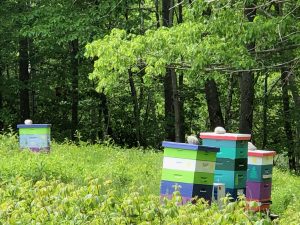by Alison Melnick Dyer
Happy Pollinator Week! Here in Maine the lupines are in bloom, and the air is finally warming up. The summer solstice brought some rainy relief from the drought we had been experiencing. And in my modest yard and in the nearby fields, I’ve noticed bees of all stripes working over the flowers.
 As a Buddhist and sometimes bee-keeper, I’ve spent a lot of time with bees. They’re beautiful to watch and listen to, and to spend time with. The contented hum of a healthy hive is incredibly soothing, and it’s fun to sit and watch them coming and going from the hive. Lately I’ve been thinking about how the lives of honeybees reflect aspects of the Dharma (as I’ve come to understand it). There are few things that bring me as much contentment as watching my bees returning to the hive, their “saddlebags” (pollen baskets baskets on their legs) filled with pollen of all colors. They are working to share their bounty with the rest of the hive, seeking to benefit all.
As a Buddhist and sometimes bee-keeper, I’ve spent a lot of time with bees. They’re beautiful to watch and listen to, and to spend time with. The contented hum of a healthy hive is incredibly soothing, and it’s fun to sit and watch them coming and going from the hive. Lately I’ve been thinking about how the lives of honeybees reflect aspects of the Dharma (as I’ve come to understand it). There are few things that bring me as much contentment as watching my bees returning to the hive, their “saddlebags” (pollen baskets baskets on their legs) filled with pollen of all colors. They are working to share their bounty with the rest of the hive, seeking to benefit all.
In the spring and summer,  honeybees work from dawn till dusk to get enough sustenance for the hive to survive. This means long forays out into the world, working over pollinating plants, searching out water sources, and learning good foraging spots from their fellow hive-mates. Bees share information with each other. They have different dances they use to communicate important sources of pollen and water. Some work away in the hive: nurse bees feeding and tending the young brood (future generations!), others packing away supplies of honey and pollen, cleaning and building new cells out of wax. Meanwhile, some are out foraging for the sake of all. They each have jobs, but all work for the good of the whole. Their work is for their own survival, sure, but also for the entire hive. Their efforts are coordinated so that the hive can flourish, and so there is enough put by for the long winter.
honeybees work from dawn till dusk to get enough sustenance for the hive to survive. This means long forays out into the world, working over pollinating plants, searching out water sources, and learning good foraging spots from their fellow hive-mates. Bees share information with each other. They have different dances they use to communicate important sources of pollen and water. Some work away in the hive: nurse bees feeding and tending the young brood (future generations!), others packing away supplies of honey and pollen, cleaning and building new cells out of wax. Meanwhile, some are out foraging for the sake of all. They each have jobs, but all work for the good of the whole. Their work is for their own survival, sure, but also for the entire hive. Their efforts are coordinated so that the hive can flourish, and so there is enough put by for the long winter.
 In the winter – the most difficult months of the year – honeybees will bunch up around the queen, fanning their wings to keep her and each other warm. They take turns with who is on the outermost edge of the bunch, the front line against the cold. And they take turns being close to the cozy center. Without the group they won’t survive.
In the winter – the most difficult months of the year – honeybees will bunch up around the queen, fanning their wings to keep her and each other warm. They take turns with who is on the outermost edge of the bunch, the front line against the cold. And they take turns being close to the cozy center. Without the group they won’t survive.
Bees work together to make the  hive viable, and there’s a really great lesson in this. We can’t get far without the sangha. If we don’t have a community of practitioners to connect and share ideas with, how can we progress along the path? If we didn’t have the wisdom of teachers – in their words, their actions, and their writing – it would be very difficult indeed to learn how to put Buddhist doctrine into practice. But being part of a sangha means offering support to those around us. Making sure that the teachers and dharma siblings have the ability to continue their practice and study, and participating alongside them. I can’t imagine a community that more thoroughly embodies this Bodhisattva ideal than the honeybee. If one of us is not free, how can any of us be?
hive viable, and there’s a really great lesson in this. We can’t get far without the sangha. If we don’t have a community of practitioners to connect and share ideas with, how can we progress along the path? If we didn’t have the wisdom of teachers – in their words, their actions, and their writing – it would be very difficult indeed to learn how to put Buddhist doctrine into practice. But being part of a sangha means offering support to those around us. Making sure that the teachers and dharma siblings have the ability to continue their practice and study, and participating alongside them. I can’t imagine a community that more thoroughly embodies this Bodhisattva ideal than the honeybee. If one of us is not free, how can any of us be?

